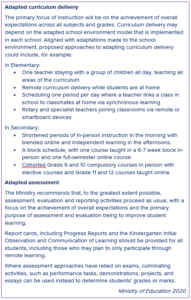Ontario’s school re-opening plans
On June 19th, Ontario’s Minister of Education announced some of the details of the province’s school reopening plans. The plan focused, for the most part, on health and safety.
This plan takes the best medical advice available from our public health experts to ensure every school board and every school is ready to ensure students continue learning in the safest way possible.
Premier Doug Ford
Schools boards to develop plans by the beginning of August
By August, school boards must submit plans that include “an adapted delivery model”, which could include alternate day or alternate week attendance, staggered bell times and recess, and different busing arrangements.
School boards plans must cover a range of scenarios depending on the public health situation. The Ministry has described the possible scenarios under three categories, but it is possible that the situation will call for a hybrid model:
- Normal school day routine with enhanced public health protocols: Students going to school every day, in classes that reflect standard class size regulations.
- Modified school day routine: Limiting groups of students to “cohorts” of 15, who would attend school on alternate days or alternate weeks, with timetabling that would allow for students to remain in contact only with their classmates and a single teacher for as much of the school day as possible.
- At home learning: School boards would offer remote education delivered with minimum expectations for students to have direct contact with their teacher at the same time on a regular basis (synchronous learning). Synchronous learning could be used as part of whole class instruction, in smaller groups of students, and/or in a one-on-one context.
The return to school in the fall of 2020-21 will be voluntary and based on parent choice. For parents who choose not to send their child back to school, school boards should be prepared to offer remote education. This requirement will be in place for as long as public health circumstances require adapted delivery of education.
Plan developed with a range of partners, but without an education-focused Task Force
People for Education continues to recommend that the Minister constitute a Task Force – with participation from all the education partners, including representatives from directors of education, teachers’ federations, principals’ councils, unions representing support staff, early childhood education organizations, trustee associations, provincial student organizations, school mental health organizations, deans of education, Indigenous education associations etc. – to ensure that the plan for education during and post-COVID is both comprehensive and coherent.
According to the government, the plan was created based on consultations with the Chief Medical Officer of Health, health experts on the COVID-19 Command Table, medical experts at The Hospital for Sick Children, as well as education sector partners. A Ministry chart makes clear that many of the meetings were separate or one-off meetings, rather than involving a collaborative group of stakeholders.
Ministry plan includes key areas
The plan includes details and direction for school boards in a number of areas:
- guidance for developing health and safety protocols, including the use of personal protective equipment;
- expectations of an in-class school environment;
- professional development training for teachers on the new protocols and directions;
- supports for students with special education needs;
- enhanced mental health and well-being supports;
- proposals on how educators and students can move fluidly between in-class and remote learning;
- guidelines to help schools and boards in their communications with students and parents;
- guidelines for student transportation systems;
- expectations for the delivery of curriculum and assessment across subjects and grades;
- guidance for working with First Nations students, parents and communities;
- regional options for re-opening based on the advice of local public health authorities; and
- a checklist to help boards in their re-opening planning.
Plan raises many questions
- Recently, many in the child care sector raised concerns that child care centres were re-opened in a very short time-frame despite expert advice on how to implement re-opening. While the Minister has been holding one-off discussions with education sector organizations, would it not be beneficial and more transparent to constitute a Task Force or Partnership Table to ensure coherent implementation of re-opening plans?
- Is the Ministry planning to adapt curriculum to ensure that learning goes beyond the basics?
- Are there plans in place for teachers to work in teams?
- The school year is over this week; how is the Ministry going to support teachers to be ready to provide a blend of online and in-person learning?
- There is no new funding in the 2020/21 Grants for Student Needs (GSN) that would allow for very small class sizes. How can school boards support classes of 15 students when their class size funding ranges from 20 to 24 students per class?
- There is very little new funding for technology beyond support for increased access to the internet and 49 cents per student for software. Will there be any extra funding for teachers and boards to use new strategies to support enriched online learning?
- Beyond mandating boards to provide laptops, are there plans to support families who – for a range of reasons – have less capacity to support students learning at home?
- How will students have access to things like the arts and health and physical education?
